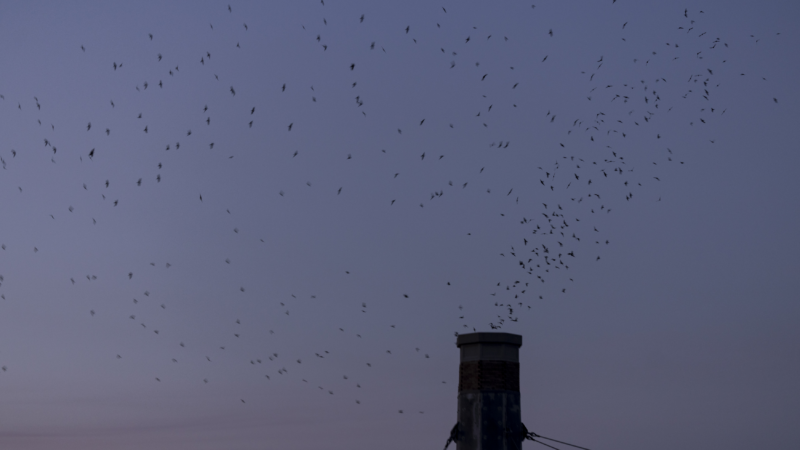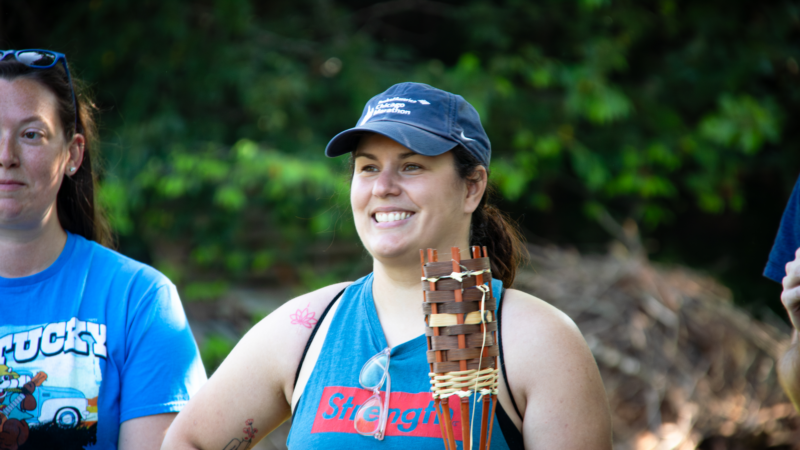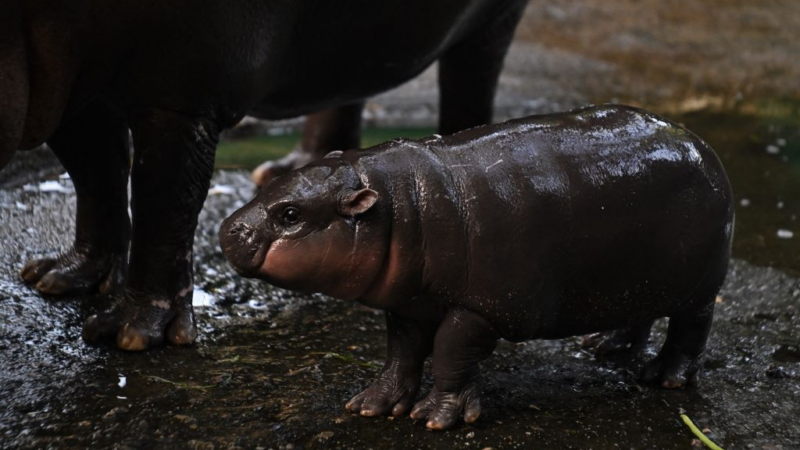In Portland, thousands gather to marvel at migrating birds’ nighttime routine
The Vaux’s Swift is a tiny bird – some people call it “a cigar with wings.” But every fall these little birds make a big trip, from summer breeding grounds in the Pacific Northwest down to their winter home in Central and South America. Along the way, many of them roost as a big flock in chimneys up and down the west coast. And their murmurations in the air – and simultaneously dive together into chimneys – are so spectacular that they draw crowds.
There have been watch parties in Los Angeles, and Eugene – and in Portland the past couple weeks, crowds turned out night after night to see these little birds go to bed. It’s part of an annual tradition known locally as “Swift Watch.”
A bird that doesn’t perch

Vaux’s swifts are about the size of a sparrow, but their closest relatives are actually hummingbirds.
“They’re so aerodynamic, and they have these swept-back wings — kind of like these fancy military jets,” says Joe Leibezeit, the assistant conservation director at Bird Alliance of Oregon.
These sleek birds do everything on the wing — eating, drinking, even mating. And, says Liebezeit, they’ve adapted to staying in the air. They’re not known to walk, hop or perch on a branch. “They’re a different kind of bird than a perching bird,” explains Liebezeit. “They don’t have the same muscle structure to do what a songbird does, to securely land on the branch and grab onto it.”
The only time they stop flying is at night when they roost. During the summer, swifts sleep in their own nests in small, residential chimneys, or the occasional hollow tree. But during the fall migration they form flocks of thousands, and huddle up in bigger smokestacks to share body heat.


While their sharp little toes aren’t great for wrapping around a branch, they’re perfect for clinging to the rough stone of a chimney. And they have even developed little barbs on their short, stubby tails to help. “Kind of like a tripod,” laughs Liebezeit.
Chain of chimneys
Historically as they migrated, Vaux’s Swifts would roost in hollow trees. But Larry Schwitters – a retired science teacher who runs a website called Vaux Happening – says they have come to prefer chimneys, because the masonry soaks up the heat of the day.
“The swifts are not good at insulating themselves,” explains Schwitters. “So they press themselves against the bricks that are releasing heat. And it can be as much as 25 degrees warmer inside a chimney.”
On the Vaux Happening website, Schwitters gathers swift counts from bird groups and citizen scientists up and down the west coast. All together, it’s tens of thousands of birds, roosting at about a dozen major sites, about a day’s flight apart.


Once the swifts get to a site, they’ll stay and feed for a day or two before moving on to the next one, says Joe Liebezeit.
“They’re gathering energy, they’re gathering fat stores on their body because they have to migrate hundreds of miles to the next stopover point.”
Although humans have provided these cozy brick hotels for the swifts, it hasn’t always been a seamless relationship. Some of the old smokestacks have been torn down because of development. Some old chimneys have been capped, because people don’t want to deal with the birds (or their poop). And newer chimneys have metal liners, which the birds can’t cling to.
Flocks of birds, flocks of people

In Portland, a chimney at Chapman Elementary School has hosted a flock of swifts since the 1980s. The Portland swift count tends to peak in mid-September – this year, the first birds were counted August 26th, and the most birds were counted September 2nd (over 5,000).
When it’s swift time, Portlanders grab picnic blankets and lawn chairs, and stake out swift-watching sites on the lawn surrounding the school. Groups share takeout and potluck picnics, while kids slide down the hill on sheets of cardboard.

“This is a very Portland thing, that there’s hundreds of people gathered on a school lawn to watch birds fly into a chimney,” jokes Jeremy Lui, as he settles in to watch. (That night Bird Alliance of Oregon counted 1,500 people there.)
About an hour before sunset, the birds begin to gather in the sky, and the crowd gasps and claps as the formation swirls around.
Suzi Asmus, who is out celebrating her birthday, says “I love when everybody starts oohing and aahing together – it just feels like a community event.”
Asmus is one of five people out celebrating a birthday on this particular September night. But really, everyone seems to be having a party. People are running into friends, sharing pizza with strangers, complimenting dogs and babies.


“The vibes, the family-centricness of it all is really sweet,” says Dylan Winkler. “That people just come and sit on a hill for hours to watch birds is so wholesome.”
But this wholesome night is not without its drama. At one point, a juvenile Cooper’s Hawk flies up to perch on the chimney, aiming to pick off a meal from the flock. The crowd collectively boos as the hawk grabs his prey. Cameron Trost, a volunteer with Bird Alliance of Oregon, isn’t one of them. He says the hawk “is indigenous to the area, so we support his efforts.”
A short time after sunset, the flock’s circles start dipping closer and closer to the chimney, their loose swirl starts to funnel, and the excitement of the crowd picks up. The amount of time it takes for the swifts to actually enter the chimney can vary – depending on the size of the flock, whether they’re interrupted by a hawk, and if they do it all in one pass. But on this night, the flock of about two thousand birds pours into the chimney continuously in the space of about a minute. It’s like a magic trick. And the crowd cheers.


(Celeste Noche | for NPR)
“It’s a great connection between people all gathered together on a lawn,” says Joe Liebezeit, “and then this flock of birds that are all kind of in synchronicity, flying in a murmuration… And it’s a cool connection between two species.”
Transcript:
ARI SHAPIRO, HOST:
A visit by a famous swift has sent Portland, Ore., into a frenzy. We’re not talking about Taylor Swift, but the Vaux’s swift. It’s a tiny bird. Some people call it a cigar with wings. Every fall, these little birds make a big trip. They fly from their summer breeding grounds in the Pacific Northwest down to their winter home in Central and South America. Along the way, many of them roost in chimneys, and thousands of people gather to watch. From Portland, Deena Prichep reports on Swift Watch 2024.
DEENA PRICHEP, BYLINE: It is hard to overstate how delightful the scene is at Chapman Elementary School. There are about 1,500 people on blankets and lawn chairs sharing takeout and potluck picnics. Kids are sliding down the hill on sheets of cardboard, and everyone’s here for the same reason, including Mike Dinsdale.
MIKE DINSDALE: To see thousands, multiple thousands of birds funnel into a chimney? Are you kidding me? What more do you need?
SHERIL KLINE: It’s just like the weirdest Portland thing ever. And I love the community and all the group that comes out.
PRICHEP: Sheril Kline is one of five people we came across celebrating a birthday tonight. But really, everyone seems to be having a party. For lack of a better term, the vibes here are great. People are running into friends, sharing pizza with strangers. As 9-year-old Bella Rosenthal puts it…
BELLA ROSENTHAL: It just feels very cool and weird at the same time.
PRICHEP: About an hour before sunset, the birds start to appear and then coalesce in a swirling flock called a murmuration. Historically, these birds would roost in hollow trees, but they’ve developed a preference for brick and stone chimneys.
LARRY SCHWITTERS: The thing about chimneys is they soak up the heat of the day.
PRICHEP: Larry Schwitters is a retired science teacher in Washington state. He runs a website called VauxHappening, where bird groups and citizen scientists report swift counts from chimneys up and down the West Coast. Altogether, it’s tens of thousands of birds roosting at about a dozen major sites.
SCHWITTERS: The swifts are not good at insulating themselves, so they press themselves against the bricks that are releasing heat.
PRICHEP: During the summer, the swifts sleep in their own nests, but during the fall migration, they form flocks of thousands and huddle up in chimneys to share body heat. Joe Liebezeit is the assistant conservation director at Bird Alliance of Oregon. He says these big groups stop at each spot for a couple of nights, spending their days filling up on bugs.
JOE LIEBEZEIT: They’re gathering energy. They’re gathering fat stores on their body because they have to migrate hundreds of miles to the next stopover point.
PRICHEP: Like a lot of urban nature, it’s not always a seamless relationship. Some of the old smoke stacks have been torn down because of development. Sometimes people don’t want to deal with the birds’ poop. But Liebezeit says that human-animal dance is what makes it so special.
LIEBEZEIT: It’s a great connection between people all gathered together on a lawn, and then this flock of birds that are all kind of in synchronicity flying in a murmuration, in a tornado going down into the chimney.
PRICHEP: At Portland’s Chapman Elementary School, you can see the connection. On this particular night, there’s a juvenile Cooper’s hawk perching on the chimney, trying to pick off a few swifts as they funnel in. And the crowd is not on Team Hawk.
(BOOING)
PRICHEP: As the sun sets, the cloud of a couple thousand Vaux’s swifts circles and closer to the chimney. And then, in what seems like a magic trick, they all funnel inside. It’s what everyone’s been waiting for.
(CHEERING)
PRICHEP: The last of the birds disappear into the chimney, and it’s hard to imagine a better way to spend a September night.
For NPR News, I’m Deena Prichep in Portland, Ore.
What today’s interest rate cut means for you. And, a big drop in U.S. overdose deaths
The first interest rate cut since 2020 is expected to be announced today by the Federal Reserve. And, for the first time in decades, U.S. drug overdose deaths appear to be plummeting.
‘The Substance’ is imaginary, but feminine self-hatred is real in this body horror
In The Substance, Demi Moore plays an aerobics TV star who turns 50 and is promptly ousted from her gig in Hollywood. She and Margaret Qualley duke it out this excruciating body horror tale.
I played ‘Survivor’ in someone’s backyard. Now I’m hooked on live reality games
Live reality games, or LRGs, are low-stakes, DIY versions of TV shows like 'Survivor' and 'The Mole.' A three-time player tells all!
Lael Wilcox rode around the world and then went for another bike ride
American cyclist Lael Wilcox rode more than 18,000 miles in 108 days, 12 hours and 12 minutes. She's claiming the record for the fastest woman to ride around the world.
Meet Moo Deng, the baby pygmy hippo so popular you can visit her for only 5 minutes
A baby pygmy hippopotamus in a Thailand zoo has become a worldwide internet sensation, leading to crowds at the zoo. Zoo officials say the increased attention has led to some bad visitor behavior.
Want to keep good workers? Praise them, a new study finds
New research from Gallup and Workhuman finds that employees who receive recognition on the job are 45% less likely to leave their jobs. Younger workers, in particular, say appreciation is key.







